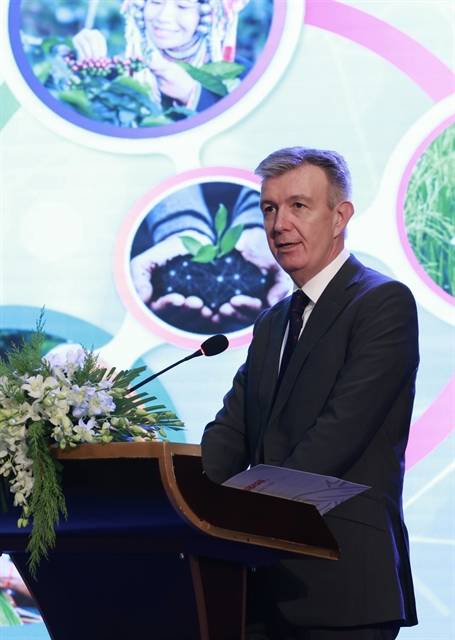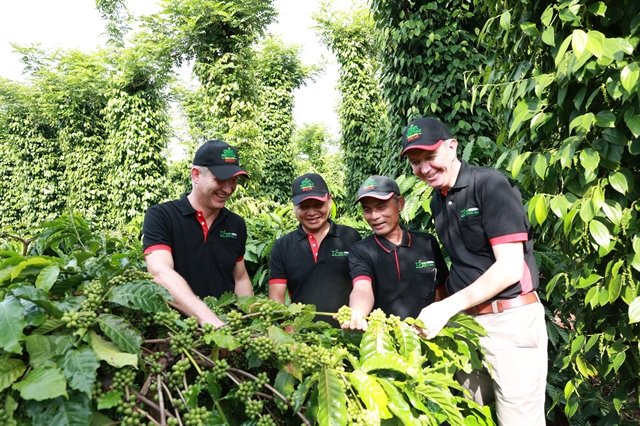 Economy
Economy

Regenerative agriculture is a farming system that aims to conserve and restore farmlands and eco-systems, and is vital for combating climate change, according to Nestlé Group, which has identified the practice as a key part of its net zero roadmap.
Việt Nam News spoke to David Rennie, deputy executive vice president and head of Nestlé coffee brands, and Philipp Navratil, head of the company’s coffee strategic business unit, on regenerative agriculture and the Nescafé Plan 2030, which focuses on helping farmers transition to regenerative farming practices.
 |
| David Rennie, deputy executive vice president and head of Nestlé coffee brands, at a conference on regenerative agriculture in Đắk Lắk Province on October 20. – Photo courtesy of Nestlé |
What are the benefits and importance of regenerative agriculture, especially in tackling climate change?
David: Regenerative agriculture is centered around universal agronomical principles that protect and restore natural resources, primarily soil, as well as water and biodiversity. It’s about working with nature over the long term to make agriculture sustainable as opposed to fighting with nature.
It has huge potential to help address climate change and reduce greenhouse gas emissions as it contributes to drawing down carbon dioxide from the atmosphere and into the soil.
For example, you look after the soil that coffee plants are growing on by retaining moisture and nutrients in it. You work on a smart irrigation system to water at the right times. Then you integrate with alternative crops that protect the coffee and give farmers an additional income. Lastly you can reduce the need for synthetic fertilisers, which have a big impact on CO2.
Why has Nestlé focused on regenerative agriculture for coffee? How has regenerative agriculture been implemented through the Nescafé Plan in Việt Nam?
Philipp: Nescafé Plan is a programme that we have been implementing in many countries, including Việt Nam. We have 12 years of a proven record of accomplishment.
As part of the Nescafé Plan, we take farmers by hand and train them in regenerative agricultural practices. We have distributed trees and provided financial support and financial literacy to them to manage the farm. This improves farming productivity and farmers’ incomes as well as soil health and reduces carbon emissions.
David: Nearly two thirds of our overall emissions come from land use and agriculture. That’s why regenerative agriculture and reforestation are a key part of our work.
Việt Nam is among the markets where the Nescafé Plan has been most successfully implemented. With our team of agronomists working with farmers in four provinces in the Central Highlands, we have been training them in better and sustainable farming practices that help save water use by 40-60 per cent, reduce the use of pesticides by 30 per cent and cut emissions.
More than 330,000 training sessions on sustainable coffee cultivation have been held.
The programme has benefitted more than 22,000 farmers in the Central Highlands Provinces, who have been issued the Common Code for the Coffee Community, rejuvenated 63,000ha of old coffee trees, and resulted in many farms engaging in intercropping with three species on average.
 |
| David Rennie (1st right) and Philipp Navratil, head of Nestlé’s coffee strategic business unit (1st left) at a Nestlé coffee farm in Đắk Lắk. Regenerative agriculture is crucial in reducing emissions and tackling climate change, and is at the core of the Nescafé Plan 2030. – Photo courtesy of Nestlé |
How does Nestlé monitor the road to regenerative agriculture?
David: Monitoring both processes and outcomes will enable us to ensure timely intervention. That is why in Việt Nam we are working closely with the Ministry of Agriculture & Rural Development, the Western Highlands Agriculture & Forestry Science Institute, provincial departments, rural extension services and other organisations.
Tackling climate change cannot wait. And we are delighted to be working with the Vietnamese government and are absolutely united in our ambition to achieve net zero emissions by 2050.
What are the challenges for Vietnamese businesses and farmers in adopting regenerative agriculture practices?
Philipp: Transitioning to regenerative agriculture is not rocket science, but it takes time and commitment for people to convince farmers it is the right thing to do.
This is the biggest challenge because in the short term there will be a slight dip in profitability or farm yields. There will be benefits afterwards but that is not immediately obvious. We need incentives and have to help farmers financially transition to regenerative agriculture, or they might not commit to the programme.
For our programme, in addition to financial support in the first few years, we are also looking into crop insurance against extreme weather conditions such as droughts, storms and heavy rains.
Nestlé cannot do this alone; we must partner with relevant authorities and organisations. So another challenge is to really work together effectively to achieve targets by 2030 or 2050.
Nestlé has just launched the Nescafé Plan 2030. What is it? And what are its goals?
David: Nescafé Plan 2030 is Nescafé’s sustainability ambition for the next decade. It is an evolution, built on the foundations of the work we have been developing since 2010 and taking it to the next level.
To help farmers transition to regenerative agriculture, we will invest more than a billion Swiss francs by 2030 in the Nescafé Plan to achieve Nestlé’s net zero commitments of 50 per cent CO2 reduction by 2030 and complete elimination by 2050.
The plan also targets having 20 per cent of its coffee sourced through regenerative agricultural methods by 2025 and 50 per cent by 2030 in addition to achieving 100 per cent recyclable and reusable packaging by 2025.
Our priority is to expand regenerative agriculture practices to seven countries from where we source 90 per cent of our coffee: Việt Nam, Brazil, Mexico, Colombia, Côte d’Ivoire, Indonesia, and Honduras.
How do you see Việt Nam’s potential in terms of your coffee business plan?
David: I’m really excited about the potential of Việt Nam in terms of coffee, as it is the second largest producer in the world. Nestlé, the world’s largest coffee company, sources more from Việt Nam than any other country.
Coffee is a key industry for Nestlé in Việt Nam. Last year we announced the expansion of a coffee factory in Đồng Nai Province’s Trị An Commune, spending US$132 million to double its size and increase its ability to export to another 26 countries across the world.
Việt Nam is an important growth driver in the Southeast Asia region for the company. We see Việt Nam’s potential in future as a global and regional manufacturing hub, and we will continue to expand our sustainable investments there, particularly in the coffee sector. VNS




